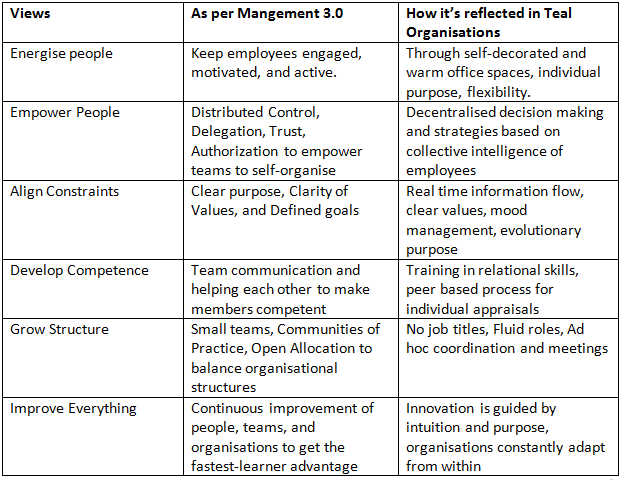It’s 2020 and we are potentially on the verge of a new breakthrough in human collaborative hierarchy and the colour of this breakthrough is “Teal”!“Every time humanity has shifted to a new stage, it has invented a new way to collaborate, a new organisational model” – Frederic Laloux
The term ‘Teal organisations’ was coined by Frederic Laloux in his book “Reinventing Organisations” in 2014. Laloux describes five stages of human consciousness, and ideates that organisations evolve according to these same stages.
They are:
They are:
Characteristics of a Teal Organisation:
Teal organisations are defined by the author as a “living organism” with 3 core principles that form its DNA:-
- Self - Management –Teal organisations work without the need for consensus and static hierarchy. Rather, the focus is on distributed authority and collective intelligence through which natural hierarchies emerge according to the situation. It promotes Holacracy over Hierarchy.
- Wholeness – One does not need to put on a job mask when at work. In teal organisations people bring their whole personality to work and not just the characteristics that are considered to be professional.
- Evolutionary Purpose – In teal organisations, money is just a means to an end, and not the end. They strive for a higher purpose. Instead of predicting and controlling the direction of the organisation, members strive to achieve the sense of the organisation and understand where the organisation is ultimately drawn to go.
Management 3.0 and Teal
Management 3.0 stands for agility and modern leadership and essentially views an organisation as a living system. Teal organisations reflect the prospective and societal view of the world. It is fair to say that both these models have an important role to play in the future of management. Let us have a look at how the views of management as per management 3.0 and teal organisations are integrated.
Thus, Management 3.0 and Teal have a lot in common. However they do have a point of difference. While Management 3.0 looks at the organisation from an internal perspective, and claims that managers are still necessary. Teal views organisations from a societal perspective by focusing on individual people constituting this society.
"It is important to have a ‘Teal’ mindset than be a ‘Teal’ organisation."
Teal in Practice
There are organisations who are successfully applying the principles of teal. At Patagonia, for example, the company has a child development center inside the headquarters for its employees’ kids . Kids visit their parents’ desks, their chatter and laughter are frequently heard throughout the organisation. At yet another Teal Company – Sounds True, people often bring their dogs to work. FAVI has a unique onboarding process which allows the new teammates to write an open letter to the colleagues they have joined. Such environments not only help people to reconnect with deeper parts of themselves but also allows them to feel as part of a common humanity.
So is Teal the New Black?
The Covid-19 Pandemic has forced most organizations to evolve n the way of working and culture. One cannot deny that the principles of Teal gives businesses what it takes to keep up with the environmental changes, ethical challenges, as well as social responsibility. However, a complete shift to teal seems to be risky and over ambitious. Popular beliefs about organisations such as a control and budget vision, top leadership, ownership by board members are deeply embedded in the organisational culture.
To go teal would mean a radical change and might be unfit for today’s beliefs about how an organisation should work. However, pioneers have shown that this model might be the key to economic, social, and environmental success, and has the potential to revolutionize the world as we know it today.
Posted in : Future of Work
Views : 70058
Leave a Comment
Hey there !
Author Details
Related Blogs
Popular Tags
Subscribe Now

Related Blogs
More fromFuture of Work







